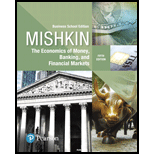
The features of a bank balance sheet.
Concept Introduction:
Balance sheet is a statement which records all the assets and liabilities of an institution for a financial year. Balance sheet indicates that;
Total Assets = Total Liabilities + Capital
Explanation of Solution
Components of bank balance sheet:
Liabilities:
Checkable Deposits: These are the bank accounts in which checks cab be drawn. These are payable on demand, i.e. if a depositor requires payment, amount can be withdrawn easily and immediately. These are liability of a bank. These are usually the lowest-cost source of bank fund as the interest paid on it is negligible.
Non- Transaction Deposits:
These are the deposits which include saving deposits and time-deposits (certificate of deposits), whereas owners cannot write cheques non-transactions deposits but interest component if higher than the checkable deposits.
Saving deposits are the most common type of non-transaction deposits. Funds can easily be withdrawn or added. All the transactions are recorded in pass-book. These are interest-bearing deposits.
Time Deposits have a fixed maturity length, they cannot be redeemed at any time but they could be easily traded to any other before maturity.
Borrowings:
Banks obtain funds through borrowings made from the federal Reserve System, Federal Home Loan banks, other banks and corporations. Banks can also borrow overnight funds in order to have enough reserve requirement of Federal reserve.
Bank Capital:
This refers to the bank’s net worth and considered as the difference between assets and liabilities. These are obtained by selling new equity(stock) or from
Assets:
Reserves:
These are the funds which a bank deposits at the Fed and the currency which physically held by banks. This is mandatory for all commercial banks to keep some part of their deposits in Fed according to the reserve requirement ratio. They are most liquid of all types as it could be easily withdrawn in case commercial bank has
Securities:
They are important earning assets of banks. These provide revenue to banks. There are different types of securities, yet U.S. government and agency securities are the most liquid because these can be easily converted into cash and can be traded with low-transaction costs. Because of the high liquidity, these are called secondary reserves.
Cash Items in process of collection:
If a check is to be withdrawn and deposited in another account but funds are not obtained but will be paid in few days; that check refers to the sash Items in process of collection.
Deposits at other banks:
Small banks hold deposits in large banks which includes check collection, foreign exchange transactions, security purchase.
Loan:
It is an asset for a bank as it earns interest. These are less-liquid than other assets because these cannot be turned into cash until loan matures.
Other Assets:
It includes buildings, computers and other equipment owned by banks and these are least liquid as it takes times to convert into cash.
Want to see more full solutions like this?
Chapter 9 Solutions
Economics of Money, Banking and Financial Markets, The, Business School Edition (5th Edition) (What's New in Economics)

 Principles of Economics (12th Edition)EconomicsISBN:9780134078779Author:Karl E. Case, Ray C. Fair, Sharon E. OsterPublisher:PEARSON
Principles of Economics (12th Edition)EconomicsISBN:9780134078779Author:Karl E. Case, Ray C. Fair, Sharon E. OsterPublisher:PEARSON Engineering Economy (17th Edition)EconomicsISBN:9780134870069Author:William G. Sullivan, Elin M. Wicks, C. Patrick KoellingPublisher:PEARSON
Engineering Economy (17th Edition)EconomicsISBN:9780134870069Author:William G. Sullivan, Elin M. Wicks, C. Patrick KoellingPublisher:PEARSON Principles of Economics (MindTap Course List)EconomicsISBN:9781305585126Author:N. Gregory MankiwPublisher:Cengage Learning
Principles of Economics (MindTap Course List)EconomicsISBN:9781305585126Author:N. Gregory MankiwPublisher:Cengage Learning Managerial Economics: A Problem Solving ApproachEconomicsISBN:9781337106665Author:Luke M. Froeb, Brian T. McCann, Michael R. Ward, Mike ShorPublisher:Cengage Learning
Managerial Economics: A Problem Solving ApproachEconomicsISBN:9781337106665Author:Luke M. Froeb, Brian T. McCann, Michael R. Ward, Mike ShorPublisher:Cengage Learning Managerial Economics & Business Strategy (Mcgraw-...EconomicsISBN:9781259290619Author:Michael Baye, Jeff PrincePublisher:McGraw-Hill Education
Managerial Economics & Business Strategy (Mcgraw-...EconomicsISBN:9781259290619Author:Michael Baye, Jeff PrincePublisher:McGraw-Hill Education





